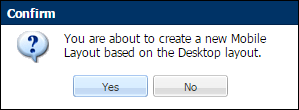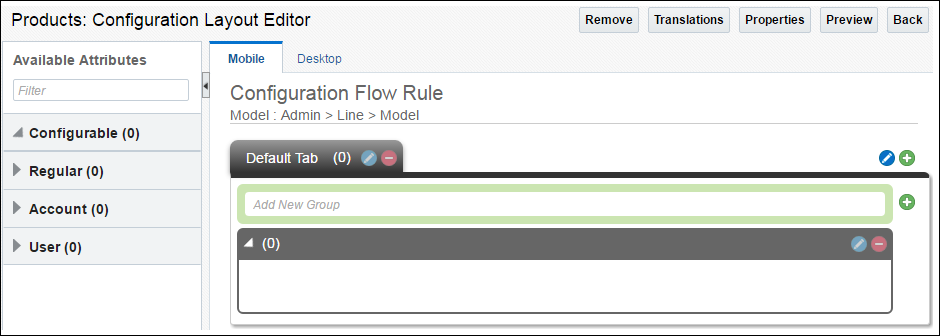Mobile Layouts for Configuration
Overview
Layouts are automatically configured to recognize if a user is on a mobile device. Optimized layouts exist for both Configuration and Commerce activities.
Mobile Configuration includes:
- Support for mobile-specific layouts
- Defined device-specific field displays
- Optimized page load and design
User Interface
 User-side Interface
User-side Interface
Administration
 Admin-side Interface
Admin-side Interface
- Mobile layouts are created within the Flow Properties page.
- Mobile layouts are initially generated to contain the contents of the Desktop layout.
- Edit Mobile layouts to contain fewer attributes than that of the Desktop layout. However, the Mobile layout cannot contain attributes not on the Desktop layout.
- To regenerate the Mobile layout, delete the Mobile layout and restart the “Create Mobile Layout” process.
- Array sets can be dragged-and-dropped from the sidebar into groups.
- Array sets contain a Delete button, but no Edit button.
- Attributes within the sets contain Edit buttons, but no Delete buttons.
- Array sets are ordered according to the associated set order.
Array Control Attributes must be located on the same tab as the Array Set they control.
 Custom JavaScript revisions
Custom JavaScript revisions
Sites using custom JavaScript must review where custom JavaScript has been implemented for mobile layouts to appear as expected.
Custom JavaScript is usually implemented in the following areas:
- Headers
- Footers
- JavaScript files uploaded to the File Manager through Configuration or Commerce HTML Attributes
 Creating a Mobile Configuration Flow
Creating a Mobile Configuration Flow
- Navigate from Admin Home Page > Products > Catalog Definition > All Product Families > List > Select Product Family > Configuration Flow
- Click Add to create a new flow rule.
-
Enter the Name, Variable Name, and Description of your rule.
The Variable Name field populates automatically. Variable names can only contain alpha-numeric characters and underscores. The entry can be changed before saving, but after saving the value is read-only.

- Select the Status of the rule.
- Active: The rule must fire if the condition is satisfied.
- Inactive: The rule does not fire, even if the condition evaluates to true.
- Internal: Only fires if the FullAccess user is the user and the condition evaluates to true.
-
If applicable, click Edit Start/End Dates to select the time period for which the rule is valid.
If no Start/End dates are selected, then it is assumed that the status is valid until the FullAccess user changes it.
- Choose your Condition Type.
- Specify the Wizard Node Type:
- Start Node: Where the config flow will begin. You can have more than one start node, so if you plan on having multiple, this will be what you set your beginning nodes to.
- End Node: Final node of the flow. This is where you'll see your action buttons like Add to Quote, as well as any recommended line items. As with start nodes, you can have multiple end nodes. The proper end node is set by attributes in the condition.
- Start and End Node: Start and End Nodes are combined.
- Transition Node: Transitions user from one node to another based on attribute selections.
- Primary Start Node: When there is more than one start flow, this lets the application know to start here first.
- Primary Start and End Node: Primary Start and End nodes are combined.
-
Click Add.
The buttons shown below appear below the newly created Configuration Flow Rule:

-
Click Layout and select Create Mobile.
The Confirm dialog box appears.

For more information on Configuration Flows and/or creating a Desktop Configuration Flow Rules, see the topic
Configuration Flows.
-
Edit Configurable, Regular, Account, and User Attributes on the Mobile Configuration Layout Editor.
This editor functions like the Email Template Editor; for more information, see the topic Email Templates Overview.

-
Select the Desktop tab to make changes to the Desktop Configuration Flow. This will direct you to the following page:

-
Click Layout Properties.
The Layout Properties dialog box appears.

- Specify the Processing Event:
- Action: The condition for the flow is evaluated when an action occurs (the user clicks a button) on the Model Configuration page.
- Value Change: The condition for the flow is evaluated when the users change a value for a configuration attribute.
- Tab Change: The condition for the flow is evaluated when the users move from one tab to another on the Model Configuration page.
- Select a Stylesheet from the drop-down. Click the pencil icon to make changes to the stylesheet.
- Select Tab Loading Behavior:
- Load all tabs on page load: Loads all data across tabs.
Load only active tab on page load: Loads data on only the active tab in configuration.
Users might see a loading page appear when the switch tabs, as the next set of data is being loaded. Select this option improves performance and rendering speed on larger configuration flows.
- Select a Template. Click
 to preview the template.
to preview the template.
- Click Ok;. The Layout Properties dialog box closes.
- Click Save.
- Click Add to begin setting up the user-side layout.
Desktop and Mobile Layouts are considered separate Flows. If a change is made to one Flow, it will not automatically be updated in the other Flow.
You must make changes in both the Desktop and the Mobile Layout
For more information on the Desktop Layout, see Configuration Layout Editor.
Dragging & dropping elements between Mobile Configuration Layout Editor tabs is an efficient way to create mobile layouts.
-
Navigate to Admin > Product Families > Configuration Flows- List

-
Click the Mobile Configuration Layout Editor link.

- Select the Element from the current Tab that you wish to move to another Tab.
-
Drag the Element and hover over the desired Tab.
The Tab opens so the element can be dropped onto the layout.
- Drop the Element onto the Layout of the desired Tab.
- If desired, click the Desktop link on the Configuration Flow Rules List page or the Desktop tab at the top of the Configuration Layout Editor to edit the Desktop version of the Configuration Layout Editor.
Desktop and Mobile Layouts are considered separate Flows. If a change is made to one Flow, it will not automatically be updated in the other Flow.
You must make changes in both the Desktop and the Mobile Layout
For more information on the Desktop Layout, see Configuration Layout Editor.
Notes
Although the mobile layout is visible in iFrame, optimal user experience is achieved through the full window. The “Occupy entire window when the site is inside a frame” parameter controls the iFrame setting for both Desktop and Mobile layouts. This parameter is located in General Site Options.
To control this parameter, the user must select “True” to occupy the entire window when the site is inside a frame.
Pages with a large number of attributes or array rows could see performance issues. It is highly recommended that users break up large sets of data to mitigate potential performance issues.
Migrations will fail if the destination site and source site Mobile Enabled settings are not identical.
Configuration calculators are not supported on Mobile.
Related Topics
 See Also
See Also
![]() Creating a Mobile Configuration Flow
Creating a Mobile Configuration Flow
 to access the tabs not shown in the header.
to access the tabs not shown in the header.





 to preview the template.
to preview the template.






